Website Audit Tool
Boost your website’s performance with the best website audit software on the market, developed in collaboration with our partners at SE Ranking. Simply enter your URL and get insights on your website’s SEO health with 120+ factors analyzed.
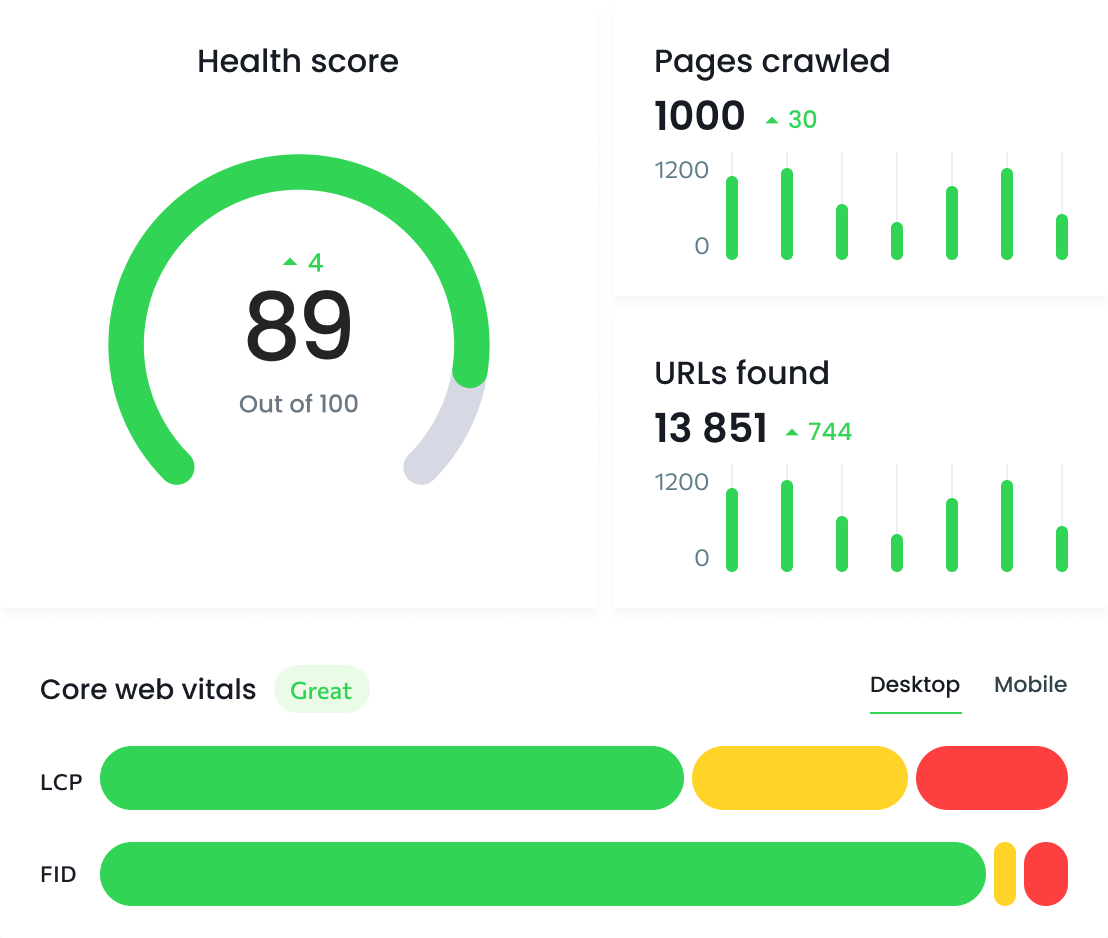
Effortlessly Identify Issues Holding Back Your Rankings
Process massive websites with ease, crawling thousands of pages in minutes and handling complex projects with up to 150,000 pages.
Make informed decisions on how to fix website issues with clear, actionable recommendations based on the best SEO practices.
Decide whether to perform a manual check or set up automated scans. Choose which pages to analyze and what metrics you want to focus on and set a scan schedule.
Examine audit findings by both severity level and issue category
Upon completing the website analysis, our system generates a comprehensive issue report where you can find in-depth insights on issues affecting your website’s performance. All detected issues are categorized into 19 separate sections like Website Security, Crawling, Duplicate Content, Usability, Website Speed, Redirects, Mobile Optimization, and so on. Not only that, we prioritize the issues for you based on their severity, from the most critical problems to simple notices for you to take a look at. This way, you can focus your website improvement efforts on what matters most.
Examine audit findings by both severity level and issue category
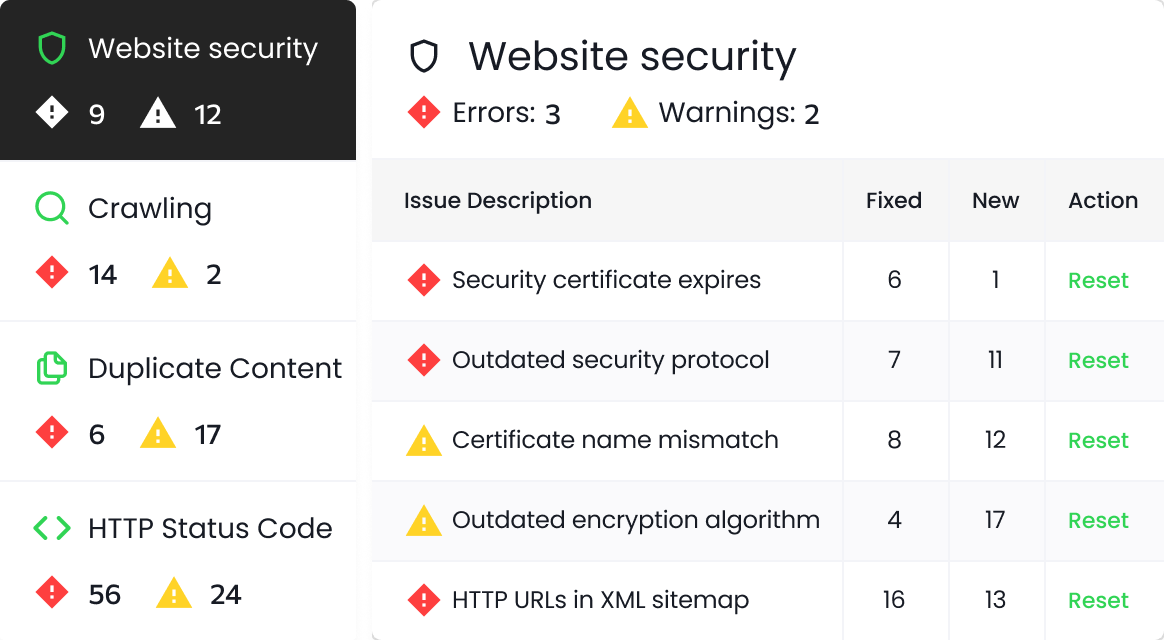
Get quick fixes and solutions for each detected problem
By clicking on a particular check, you’ll see a complete list of pages affected by the issue as well as a clear explanation of the problem. This block also features easy-to-follow instructions on how to resolve this error. With recommendations provided by the system, you’ll be able to fix the issues yourself without needing to spend time interpreting complex technical terms or searching for online solutions. This will allow you to maximize your efficiency and deliver high-impact results while saving time.
Get quick fixes and solutions for each detected problem
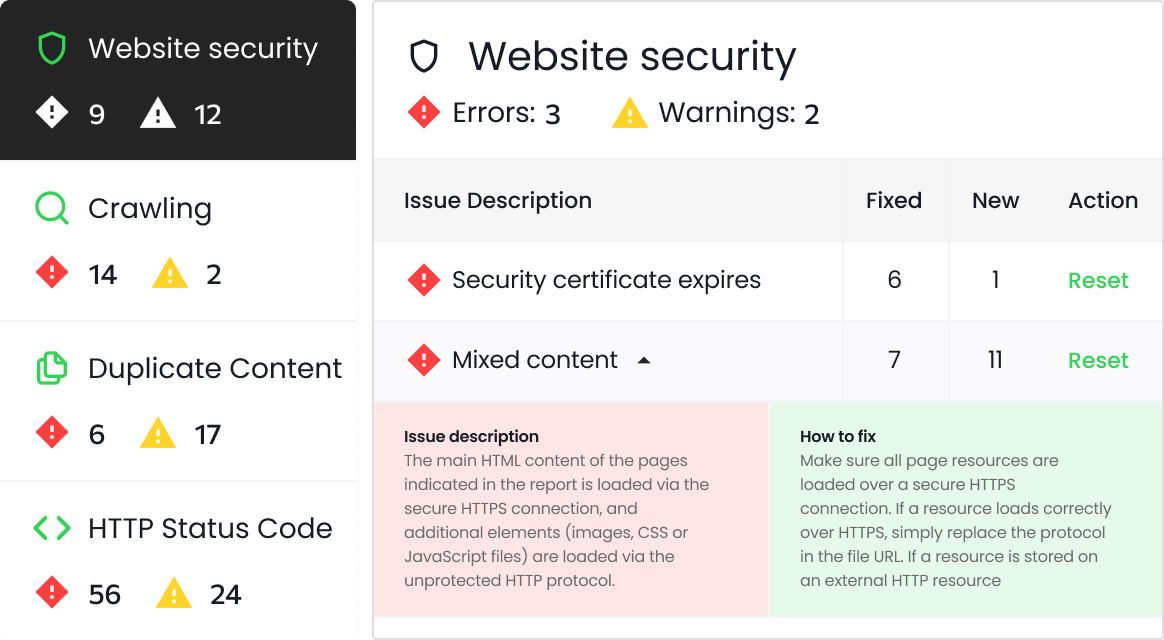
Evaluate each crawled webpage against key SEO metrics
Under the Crawled Pages block, you can find the full list of webpages examined during the audit. These URLs are also analyzed against a set of essential parameters like referring pages, type and version of URL protocol, presence in the sitemap, server response code, robots.txt blocking, nofollow/dofollow status, etc. Plus, all crawled pages can be sorted by the errors, warnings, and notices that they contain. Using this report, you can conveniently filter out data of your interest and easily export results of the website technical audit in the .xls or .csv file format.
Evaluate each crawled webpage against key SEO metrics
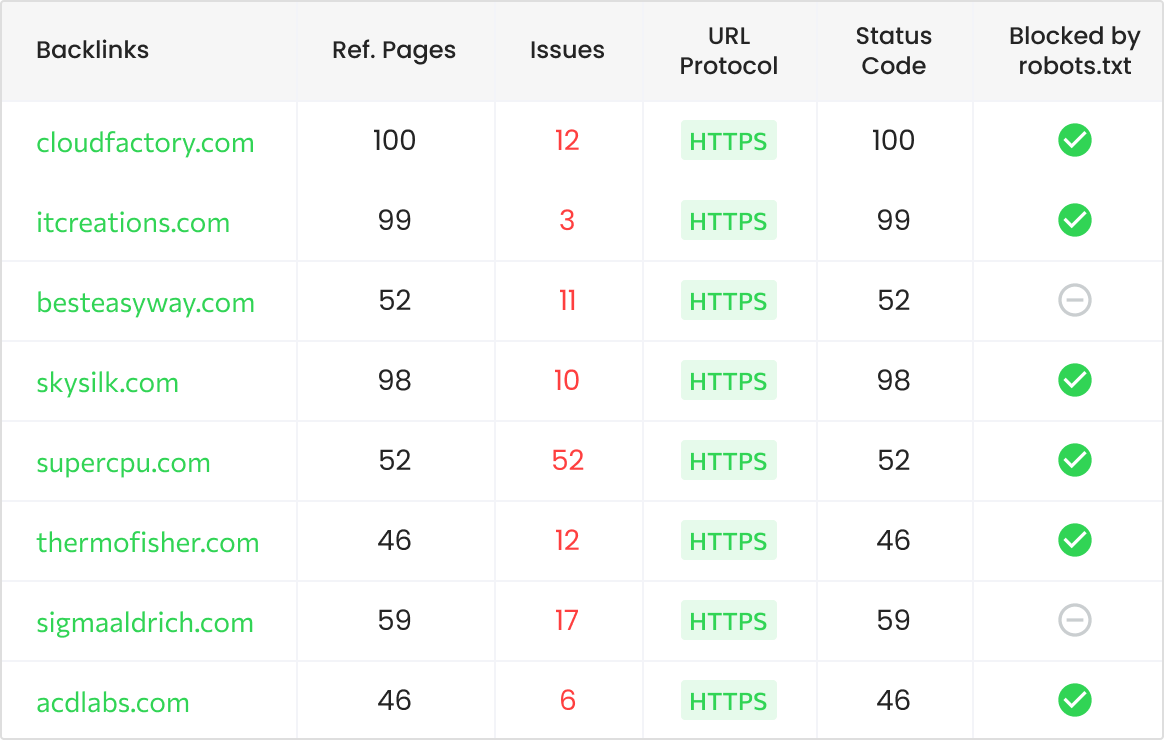
Analyze changes and trends in audit results over time
Let’s say you’ve performed a website SEO audit at least two times and want to compare the results of each examination side-by-side. All you need to do for this is go to the Crawl Comparison section. Here, you’ll be able to see whether your optimization efforts have paid off and which issues still require your involvement. Just pick two dates, and the system will automatically show a comparison table with audit results.
Analyze changes and trends in audit results over time
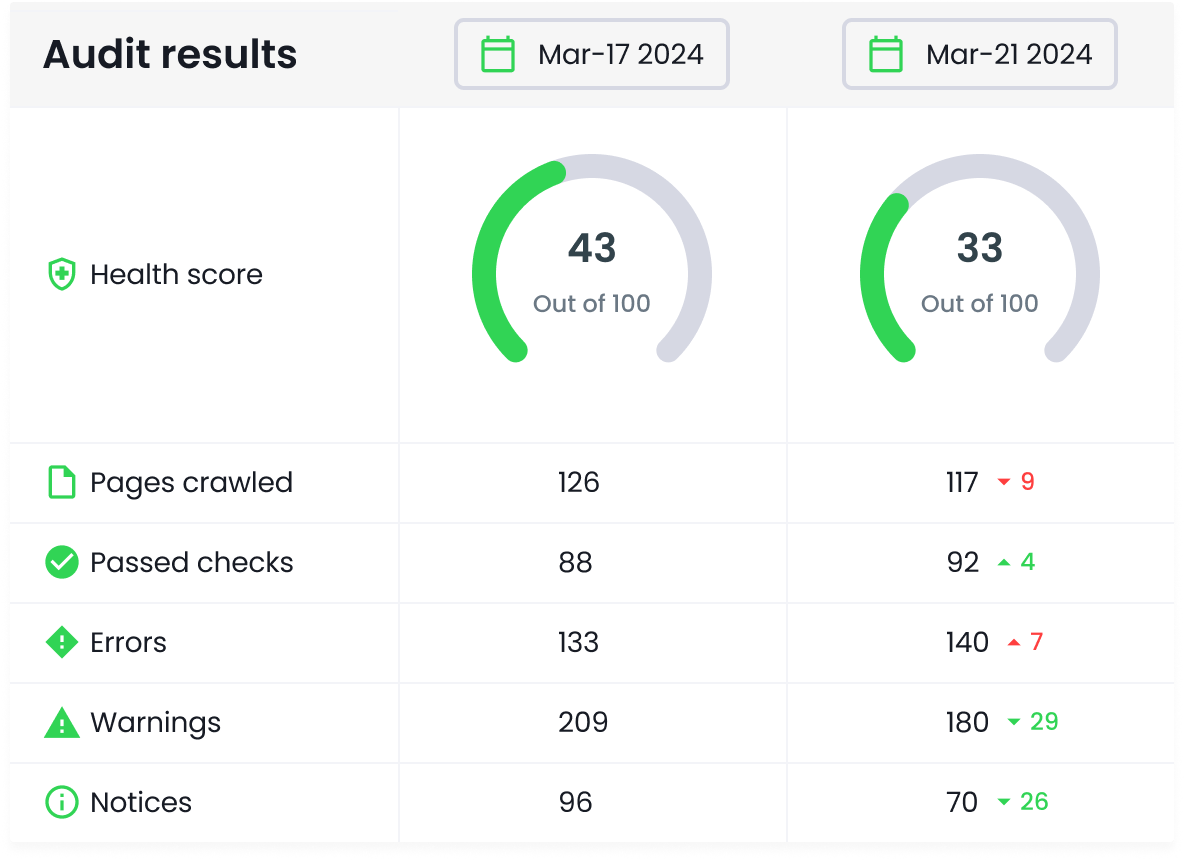
Flexible Pricing Plans to Match Your Data Needs
With our subscription options, you can get access to premium features at a fair price and easily scale as your data needs grow.
Essential
For freelancers and newbies seeking essential SEO features to tackle key tasks.
PRO
For SMBs, small agencies, and teams with more demanding data needs for SEO.
Business
For mid-size agencies and businesses managing complex projects and requiring the most extensive data.
Clients Wins Inspiring to Take Action
Discover how Website Audit has helped other businesses grow
What is a Website Audit Tool?
Website Audit Tool is a reliable solution designed to help users evaluate any website’s performance in search. It looks at over 120 different factors, starting from website security, crawlability, indexation, sitemap configuration, and Core Web Vitals to metadata, textual content, mobile optimization, and so on.
Thanks to its advanced crawling technologies, the Website SEO Audit Tool has the capacity to crawl up to 1,000 pages within just two minutes. This makes the tool a perfect fit not only for small and mid-size websites but also for large projects.
On top of that, this tool’s audits are fully customizable and can be tailored to your specific needs. Choose the website areas to scan, deactivate irrelevant checks, and determine audit frequency based on your business goals. This will let you focus on what truly matters for your site’s health.
How does the Website Audit Tool work?
Once you input project details and launch the audit, the tool immediately starts crawling the website according to the settings you’ve set up. Upon finishing the analysis, the system sends the report straight to your inbox.
What makes this tool highly convenient is that it categorizes all detected issues into four different groups based on their severity: Errors, Warnings, Notices, and Passed Checks. Besides, each problem comes with a clear explanation and fix tips right next to it.
The tool also compiles a list with all individual web addresses found on your website. Each page, starting from the homepage to every internal link, is analyzed against core SEO parameters. This way, you have the opportunity to analyze your website’s performance on a page-by-page basis.
What are the benefits of Website Audit Tool for SEO specialists and agencies?
Our Website Audit Tool offers a wide range of benefits that can help you boost your website’s rankings, improve user experience, and ultimately drive more traffic and conversions. In particular, these are the following:
- In-depth SEO insights: Our website audit service features comprehensive reports on technical SEO, Core Web Vitals, security, user experience, page indexation status, HTTP status codes, internal/external links, metadata, and so on.
- Categorized issues: All website issues are divided into groups depending on their significance so that you can prioritize all your efforts accordingly.
- Convenient progress tracking: With the Crawl Comparison feature, you can compare audit results over time to determine the impact of your improvements.
- Easy-to-understand data presentation: Collected audit insights are presented using clear dashboards, graphs, and tables to make your experience as effortless as possible.
- Customizable audit settings: The tool allows you to specify which pages to audit, which checks to perform, and how often you want your website to be crawled.
- Fast and scalable crawling: Our online website audit tool can process 1,000 pages in just two minutes, making it perfect for websites of all sizes, even those with up to 150,000 pages.
- Actionable tips to fix issues: Apart from the list of categorized issues, each identified problem comes with a clear explanation on how to deal with it.
FAQ
What is a website audit?
A website audit is a comprehensive checkup of a website aimed at assessing its performance and identifying issues affecting its visibility in search engines. During this process, the site usually gets analyzed in terms of its technical functionality, SEO performance, content quality, UX, usability, and so on. Based on the collected data, you can develop a prioritized action plan to fix detected problems and, therefore, increase your chances of acquiring high SERP positions.
Why do I need a website audit?
Regular website audits are crucial for several reasons. First of all, they help understand how healthy a particular website is. Secondly, such audits are particularly useful for identifying errors preventing your website from functioning properly. Upon completing this examination, you can make a list of pages and issues that need to be revised and fixed. Finally, website audits can highlight aspects that are not yet a problem but have the potential to harm the website’s health.
Which issues can be identified during website audits?
Since there are many types of website audits, the range of identified issues can differ from case to case. Here’s the list of the most common issues you may identify:
- Technical functionality: indexation problems, poor Core Web Vitals, incorrect server responses, duplicate content issues, misconfiguration of the sitemap and robots.txt, etc.
- SEO performance: problems with the usage of keywords, meta tags, URLs, backlinks, site structure, design, navigation, accessibility, usability, etc.
- Content quality and relevance: issues related to content relevancy, readability, text length, use of visuals, etc.
How often should I get my website audited?
Ideally, the frequency of website audits should be determined based on several factors: how well your website performs, how big your website is, and how often your website gets updated. Large websites with complex structures usually require frequent audits. The same applies to websites experiencing significant fluctuations in rankings/organic traffic/conversions, etc. At the very least, aim to conduct audits quarterly (every 3 months).
How can I track the progress made after fixing website audit issues?
Once you’ve addressed audit findings, monitor your website’s performance using analytics tools like Google Search Console, Google Analytics 4, and reliable SEO platforms like SE Rankings. In the latter case, you’ll be able to compare audit results side-by-side to see areas that have improved and those requiring further work from your side.

